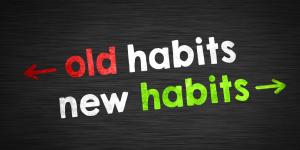The Best Memory Strategies - Fast Memorization


Among the best memory strategies we find the fragmentation of information, mental associations, reading aloud, acrostics, rhymes and many more. These memorization techniques are methods of helping you to remember large chunks of information quickly. This is something which is helpful in many situations, such as when you want to pass an exam or make a presentation, but they can even be useful for the more banal elements of everyday life.
Memory is a vital cognitive functions that allows us to both store information and retrieved it when necessary. The best memory strategies allow us to both retain and access this information with ease. This is why oneHOWTO provides these fast memorization techniques to ensure you can access your memory whenever you need it.
- The operation of memory
- Fragmentation
- Mental associations
- Reading out loud
- Acrostics
- Rhymes
- Songs
- Storytelling
- Mind maps
- Memory cards
- Take notes
The operation of memory
The best memory strategies work because they allow our brain to deal with information in the best way. To do this, we need to understand how the brain processes information to create memory. While there is much we are yet to understand, there is a generally accepted basic process of memory creation:
- Attention: if the brain considers information important, it retains it.
- Encoding: information that has been interesting is moved to either short-term memory (which retains it for a few seconds) or to working memory (which retains it for approximately 20 minutes, but is then forgotten).
- Storage: important information can be moved from short-term memory to long-term memory, but this is done only if you decide to do so. This requires applying memory techniques.
- Retrieval: the better information is encoded and stored, the faster it can be retrieved and used.
Now we know how the basic of memory work, we can find out what are the best memorization techniques to access memory. This can be helpful for important events such as exams, but it can also help you if you have a difficult time memorizing in general.
Fragmentation
Fragmentation, in the context of memory, involves breaking down complex information into smaller, more manageable pieces. This approach benefits memory retention and access by making information more digestible. It helps encode and store information effectively, reduces cognitive load, and encourages efficient retrieval.
When you learn in smaller fragments, your brain can focus on one piece at a time, making it easier to process. It promotes interleaved learning, which enhances memory by preventing over-practicing and encourages the brain to work harder to retrieve information. The structured approach of fragmentation also facilitates pattern recognition, adaptation in learning strategies, and deeper understanding of the material. Ultimately, fragmentation aids long-term retention, supports adaptive learning, and allows for the efficient organization and retrieval of information.
For example, if you needed to learn a long piece of text from a book, memorizing the entire piece at once is almost impossible. Here's how you might apply the fragmentation technique:
- Read the first sentence of the paragraph and try to understand its meaning.
- Once you've grasped the first sentence, close the book or document and recite the sentence from memory.
- If you can recall it accurately, move on to the second sentence and repeat the process.
- Continue this process sentence by sentence until you've covered the entire paragraph.

Mental associations
Mental associations are a powerful technique for memorizing information by linking it to familiar or memorable mental images. It involves creating vivid and imaginative connections between the new information you want to remember and something you already know or can easily visualize.
For example, if you need to remember a list of items like milk, eggs and bread, you can create mental associations as follows:
- Milk: imagine a cow in your kitchen, happily pouring milk from a pitcher.
- Eggs: picture a giant egg carton on your living room couch, filled with oversized eggs.
- Bread: visualize slices of bread as your bedroom's floor, making it difficult to walk without stepping on them.
These quirky mental images make the items memorable by linking them to familiar settings or objects in a unique and humorous way. When you need to recall the list, you can mentally walk through your "story," and the associations will trigger the items you wanted to remember.
This technique enhances memory retention by engaging your creativity. Making the information more vivid and personalized will make it easier to retrieve when needed.
Reading out loud
Reading out loud is an effective technique for memorizing information because it engages multiple senses and cognitive processes. In doin so, the material becomes more accessible and memorable. When you read content aloud, you reinforce your understanding and retention by adding hearing and speaking to visual learning.
For example, suppose you're trying to memorize a paragraph about the importance of exercise:
- As you read this passage aloud, the words become audible, allowing your ears to register the information. This auditory input complements the visual cues you receive while reading silently.
- Furthermore, vocalizing the text involves speaking and articulating the words. This physical engagement enhances your kinesthetic memory, linking the words to your body's movements.
- Reading out loud also forces you to pay more attention to the content, as you need to pronounce the words correctly. This heightened focus strengthens your comprehension and memory of the material.
- Incorporating your sense of hearing, speech and physical activity alongside your visual input creates a robust, multi-sensory learning experience that can significantly improve information retention.
The act of vocalizing the material also creates a stronger memory trace in your brain, making it easier to recall when needed. Whether you're studying for an exam, learning a new language or trying to remember important facts, reading aloud can be a valuable tool to enhance your memory and comprehension.
Acrostics
Acrostics are memory aids that use the initial letters of a series of words or concepts to create an easily remembered phrase, making it simpler to recall information. Let's create an acrostic to remember key facts about Africa using the word AFRICA:
- A - Animals: Africa is renowned for its incredible wildlife, including lions, elephants and zebras. Remembering ‘A’ for ‘Animals’ helps you recall this unique aspect.
- F - Formation: the second-largest continent, Africa has diverse landscapes, from deserts to rainforests. ‘F’ stands for ‘Formation’, reminding you of its varied terrain.
- R - Rivers: some of the world's longest rivers, such as the Nile and the Congo, flow through Africa. ‘R’ signifies ‘Rivers’ and their significance on the continent.
- I - Inhabitants: Africa is home to a rich tapestry of cultures and peoples. ‘I’ represents ‘Inhabitants’, emphasizing the diversity of the population.
- C - Cultures: with countless languages, traditions and art forms, Africa boasts a rich cultural heritage. ‘C’ corresponds to ‘Cultures’, underlining this cultural diversity.
- A - Agriculture: agriculture plays a crucial role in Africa's economy. ‘A’ can remind you of the importance of ‘Agriculture’.
By using this acrostic, you can easily remember key facts about Africa, from its unique wildlife and geography to its rivers, diverse inhabitants, rich cultures and vital agricultural sector. This technique simplifies the process of memorizing and recalling complex information, turning it into an engaging and memorable exercise. It can be particular useful for remembering a speech since you can follow along with each letter.
Rhymes
Rhymes are an effective memory aid because they make information more catchy and easily memorable. When information is organized in a rhyming pattern, it becomes rhythmical and melodious. This can help imprint it in your mind. Our brains tend to remember things that are pleasing to the ear, and rhymes provide that pleasant auditory experience.
For example, if you want to remember the order of the planets in our solar system, you could use a rhyme like:
‘My Very Educated Mother Just Served Us Noodles’.
In this case, the first letter of each word corresponds to a planet in order (Mercury, Venus, Earth, Mars, Jupiter, Saturn, Uranus and Neptune). The rhyme not only helps you recall the names of the planets, but also their sequence.
Rhymes are often used in educational contexts because they make learning fun and engaging, helping students remember complex information more easily. They're not only for kids. People of all ages can benefit from using rhymes to remember facts and figures.
Songs
Songs can also serve as a powerful memory aid. Just like rhymes, songs make information more memorable because they add a musical and rhythmic element to it. The combination of melody and lyrics can create a catchy and enjoyable way to remember facts, making the information stick in your mind more effectively.
Think about how easily you can remember the lyrics to your favorite songs. It's the same principle at work. When you set information to music, you're essentially creating a mnemonic device that helps you remember details in the tune's sequence.
Many educational songs and jingles are designed to help people, especially students, remember important facts. These songs cover a wide range of subjects, from history and science to mathematics and language. They're a popular tool for making learning more engaging and memorable.
If you want to remember something more effectively, consider turning it into a song or finding a relevant song that already exists. You'll likely find that the melody and rhythm help the information become ingrained in your memory.

Storytelling
Storytelling is a powerful memory strategy because it transforms information into a narrative, making it more engaging and easier to remember. Here's how it works:
- Contextualization: when you create a story around a set of facts or information, you provide context. Contextualization helps your brain establish a logical framework for the data, making it easier to follow and remember.
- Visualization: stories often involve characters, places and actions. When you visualize these elements in your mind, you're essentially creating mental imagery. This is a powerful memory aid. Your brain can recall information more effectively if it's linked to visual mental cues.
- Emotion: stories can evoke emotions. When you associate information with an emotional element, it becomes more memorable. Emotions can serve as anchors for memory. You're more likely to remember information that made you feel something.
- Sequencing: stories have a natural sequence of events, which helps you remember the order of facts or steps. Your brain can follow the logical progression of a story. This sequential memory aids retention.
- Engagement: storytelling captures your attention and keeps you engaged. When your mind is actively involved in a narrative, you're more likely to remember the details. Passive learning, such as rote memorization, often results in lower retention.
- Association: stories allow you to associate information with characters, settings or plot points. These associations serve as memory hooks, making it easier to recall the information when needed.
To use storytelling as a memory strategy, take the information you want to remember and create a narrative around it. This can be a simple story or a more elaborate one, depending on your preferences and the complexity of the information. The key is to make the story engaging, vivid and relevant to the content you're trying to memorize. The more personally meaningful the story is to you, the more effective it will be as a memory aid.
Mind maps
Mind maps or mental maps are a versatile and effective memorization strategy that helps you organize and visualize information in a structured way. Here's how mind maps work:
- Visual representation: mind maps use visual elements, such as branches, nodes and connecting lines, to represent information. This visual representation engages your spatial memory, making it easier to recall details.
- Hierarchy and structure: mind maps allow you to create a hierarchical structure for your information. The main topic or central idea is placed at the center, with subtopics branching out. This hierarchical structure mimics the way your brain naturally organizes information, facilitating comprehension and retention.
- Association: mind maps promote the association of related ideas and concepts. When you see interconnected nodes and branches, you create mental links between different pieces of information. This association strengthens memory and recall.
- Sensory engagement: using colors, images and keywords in your mind map engages different sensory modalities. This multisensory approach helps imprint information more deeply in your memory.
- Condensation: mind maps encourage you to condense complex information into a concise and organized format. This simplification helps you focus on essential details, reducing cognitive load and enhancing memory.
- Active participation: creating a mind map requires active engagement with the material. As you construct the map, you're processing the information, which contributes to memory retention.
Here's how to use mind maps for memorization:
- Select a central topic: start with the main topic or idea you want to remember and place it at the center of the page.
- Add subtopics: identify the key subtopics or details related to the central topic and create branches radiating out from the center.
- Use keywords: write down relevant keywords or short phrases on each branch to summarize the information.
- Visual elements: incorporate visual elements like images, icons, or colors to represent concepts and make the mind map visually engaging.
- Connect ideas: use lines or arrows to connect related ideas and show how they are interconnected.
- Review and test: regularly review your mind map to reinforce your memory. You can also challenge yourself to recall information based on the mind map.
- Customize: customize your mind map to suit your learning style. There's no one-size-fits-all approach, so create mind maps that resonate with you.
Mind maps are particularly useful for summarizing complex topics, organizing information for exams and enhancing the understanding and retention of large volumes of data. Their flexibility makes them a valuable tool for students, professionals and anyone looking to improve memory and learning.
Memory cards
If you need to give a conference or give a presentation, you can create cards with keywords. The cards can be of different colors. There are also many electronic applications with which you can create these virtual cards. These cards can group together information and help prompt your brain when answering a question.

Take notes
Taking notes is an effective memory strategy because it engages multiple cognitive processes that enhance the encoding and retention of information. Here's how taking notes helps with memory:
- Active engagement: when you take notes, you actively engage with the information. This process requires you to pay attention, process and summarize the content, which is more effective for memory than passive listening or reading.
- Selective attention: note-taking forces you to select the most important and relevant information. This process of filtering out non-essential details helps you focus on key points, making it easier to remember them.
- Repetition: writing down information involves repetition, which is a fundamental principle of memory. The act of writing reinforces your memory as you reproduce the information in your own words.
- Organization: notes provide a structured and organized representation of the material. This structure makes it easier to review and recall information because you can see the relationships between ideas and concepts.
- Visual and spatial memory: associating information with the physical location of notes on a page engages your visual and spatial memory. You can visualize where specific details are on the page when you try to remember them.
- Summarization: the act of summarizing content in your notes helps condense information into a more digestible form. Summarized notes are easier to review, reinforcing memory retention.
- Personalization: your notes are often tailored to your unique style and understanding. This personalization makes the information more meaningful and memorable to you.
- Revision and review: notes serve as a handy resource for later revision and review. Revisiting your notes at different intervals strengthens your memory of the material through spaced repetition.
- Enhanced retrieval: the process of taking notes creates a retrieval pathway in your brain. When you need to recall the information, retracing this pathway can help you retrieve it more easily.
- External storage: notes act as memory strategy by creating an external storage system for your memory. They offload some of the cognitive burden of remembering everything, freeing up mental resources for other tasks.
- Active listening and reading: to take effective notes, you must actively listen and read the material. This active involvement in the learning process reinforces memory formation.
- Visual and kinesthetic learning: different learning styles benefit from the visual and kinesthetic aspects of note-taking. Visual learners benefit from seeing the information on paper, while kinesthetic learners benefit from the physical act of writing.
- Organization of ideas: the act of organizing information in notes helps you understand how different ideas relate to each other, creating mental connections that improve memory.
To make the most of note-taking as a memory strategy, it's essential to develop effective note-taking techniques. These include using headings, bullet points and visual aids. You will also need to review your notes periodically to reinforce memory retention.
If you want to read similar articles to The Best Memory Strategies - Fast Memorization, we recommend you visit our Learning category.







